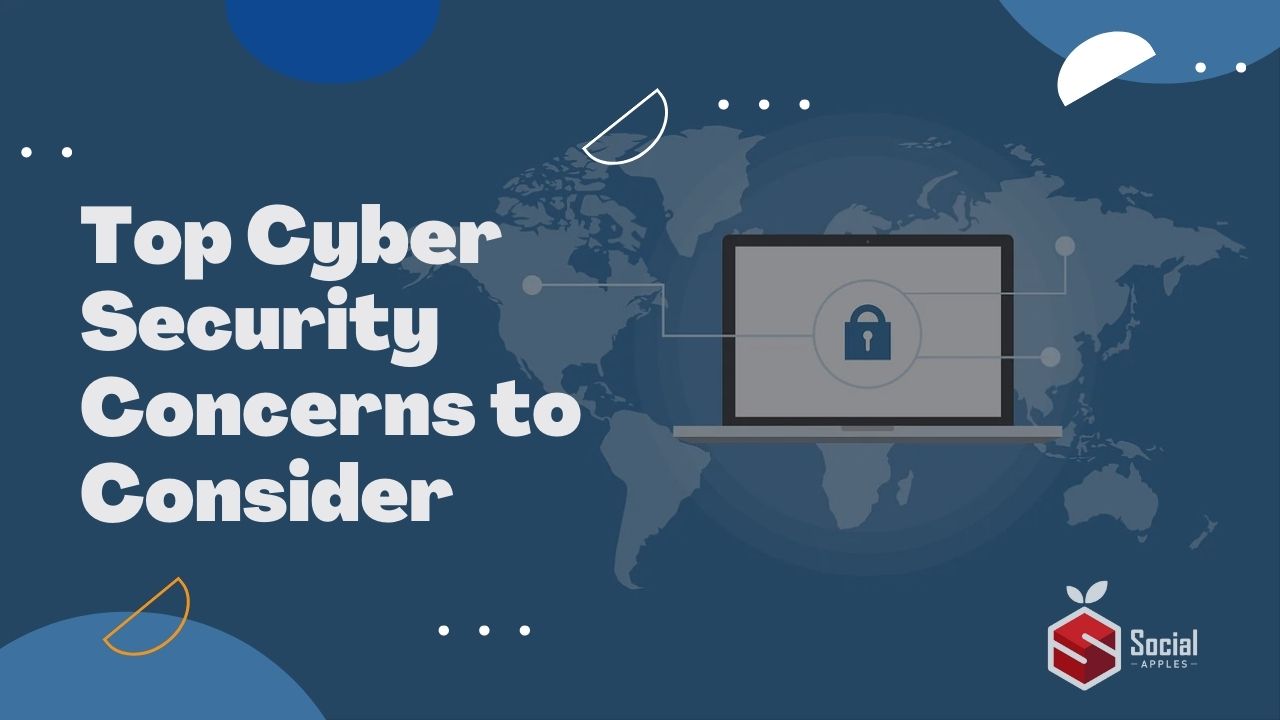In 2020, the pandemic forced all of us to stay in our homes and adjust our lives to the pandemic rules. Due to the global lockdowns and curfews, work from home models became a common practice, and in a short time, it was adopted by most employees and businesses. But, ever since remote work has come into practice, cyber crimes have been increasing enormously.
This drastic rise in cybercrime rates frightens most businesses. Every day, the cyber threat landscape evolves and catches many businesses off guard. The more businesses acknowledge the severe consequences of cyber attacks, the more they are concerned about the cyber security of their organizations.

Today, many businesses can’t risk the integrity and safety of their assets, systems, and confidential data that they collect and store. That’s why it is vital to be informed about cyber security threats that can cause unwanted data breaches and cyber-attacks. Here are the top cyber security concerns to consider.
Contents
Top Cyber Security Concerns to Consider in 2024
1. Remote Workforce
The more organizations depend on a remote workforce, the more they are up against high risks of cyber attacks. Remote workers reach corporate networks and resources from different geo-locations and create a more complex network to protect. Because inside the network perimeter, many end-points need to be protected and monitored.
Some of the devices remote workers use might be vulnerable to attacks, and weak end-points often lead to cyber attacks as they are considered gateways to corporate networks. Remote workers usually prefer to work in public places and use unsecured Wifi connections to reach corporate resources. These open wifi connections can cause cyber attacks, especially if a business doesn’t have the adequate tools to enable secure remote access.
Additionally, without proper secure remote access tools, even remote workers’ home Wifi connections can be exploited by cybercriminals. To secure remote workers, and decrease the risks related to them, businesses can implement cutting-edge technologies like Zero Trust Network Access (ZTNA), Remote Access VPN, Secure Access Service Edge (SASE), and so on.
2. Third Party Exposure
Working with third-party contractors, business associates, or vendors is a common practice for most businesses as it reduces the organizational costs and workloads of full-time employees. Although working with third-party contractors has many benefits, giving these third-party entities privileged access to corporate networks is extremely risky. Because cybercriminals can attack improperly protected third-party contractors’ networks, and afterward use contractors’ access privileges to reach their primary targets’ networks.
Simply put, giving third-party entities privileged access can put a business’s entire network at risk. For this reason, limiting third-party contractors’ access is essential. For instance, a business can implement network segmentation, create different network segments, and access portals for each third-party contractor, business associate, and vendor. Implementing this strategy can mitigate the risks associated with third-party entities. Because cyber criminals can’t accomplish their malicious goals by using compromised third-party entities’ access.
3. Cloud Vulnerabilities
Every day, cloud computing’s popularity rises among businesses, and they adopt cloud, multi-cloud, or hybrid infrastructures to store data or host applications. By all means, using cloud computing services help businesses reduce organizational costs, scale up operations quickly, and enable better application performance.
But, cloud providers embrace the idea of shared responsibility and hold cloud clients accountable for the data security of cloud assets. Lack of cloud security measures stemming from both parties can lead to cyber-attacks and data breaches easily. When cloud vulnerabilities aren’t taken care of adequately, these environments can be exposed to account hijacking and Denial of Service (DoS) attacks.
These attacks seek to possess cloud data and prevent businesses from accessing their data. For this reason, cloud vulnerabilities shouldn’t be ignored. While using cloud services, businesses should implement cloud-compatible enhanced security tools like Zero Trust Network Access (ZTNA).
Also Read: Best Free VPN For School WiFi in 2024
4. Human Errors
More than 50% of data breaches stem from human errors. Cybercriminals use phishing and social engineering attacks to exploit human errors and gain access credentials of employees. For example, social engineering attacks aim to exploit human errors to gain access to target machine systems. These attacks lead employees to reveal their credentials under a false sense of security. In this regard, phishing is a type of social engineering attack.
Phishing attacks are very popular among cybercriminals. In these attacks, cybercriminals create fake websites, text messages, or emails, posing as legitimate sites. When employees click on phishing links, cyber criminals steal their credentials or infect their computers with malware. Stolen employee credentials can be used as a gateway to access corporate networks and infect malware to corporate systems.
To minimize the security risks associated with human errors, it is critical to train employees. For instance, everybody in your organization should be informed about cyber security basics, phishing emails, social engineering attacks, regular password changes, and so on. Well-trained personnel can be more cautious about clicking on phishing links and revealing their credentials.
5. Ransomware
Ransomware is a type of malware it is constructed by malicious code that aims to infect target systems and corporate networks. When a network or system is infected by ransomware, it takes control of data storage and prevents corporate personnel from accessing vital corporate data. In essence, cybercriminals use ransomware to encrypt corporate data and hold it hostage until the ransom is paid.
Nowadays, even amateur cybercriminals can execute ransomware attacks as they can purchase Ransomware as a Service from providers. Additionally, experts predict that Ransomware damages will reach 265 billion dollars by 2031. That’s why businesses should underestimate the possibilities of ransomware attacks. Lastly, all sizes of businesses should be prepared for these attacks and implement enhanced security measures to prevent them.
Last Words
COVID-19 pandemic caused a drastic rise in cyber crimes as malicious actors started to exploit every vulnerability and weak end-points in their target’s systems and networks. Today, all sizes of businesses can be hit by cyber attacks and face severe outcomes of these unwanted events. To minimize security concerns, businesses should implement cutting-edge security technologies to protect their assets against cyber attacks.













